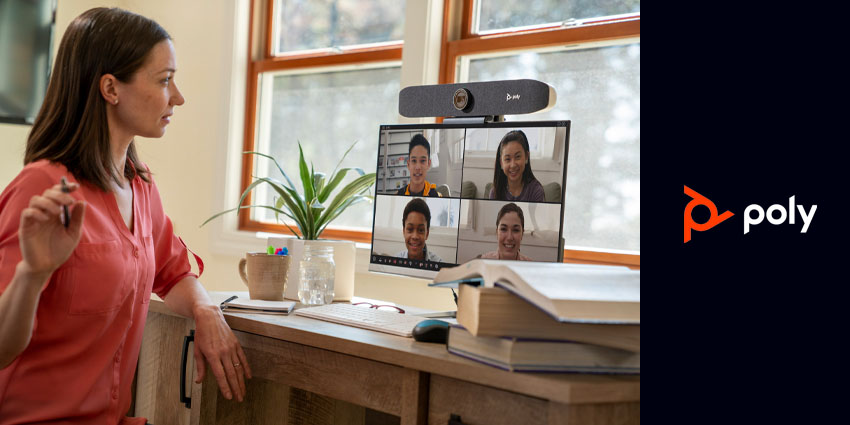The last few years have taught us all a thing or two.
We’ve learned how adaptable we all are. We’ve learned to embrace new ways of working. And we’ve learned (as if we hadn’t known it all along) how technology helps us respond to life’s big challenges.
Connecting remote workforces, powering virtual collaboration, unifying clever communication tools: this most modern of industrial revolutions has reimagined how the world works.
One of the bigger stars to emerge? Videoconferencing.
Smart, connected and feature-rich hardware brings people together like they are in the same room; transforming the way we interact with each other, shifting organizations’ culture, slashing travel costs, and minimizing distance.
All vertical sectors have benefitted big but, for education in particular, the ‘hybrid’ model – that brilliant mix of physical and virtual participation – is fuelling positive and permanent change certain to help shape a bright future for us all.
From classrooms in remote schools to entire campuses spread over several countries; teachers, pupils, lecturers and students are leveraging clever videoconferencing solutions to learn smarter.
It is a way of learning that is no longer a temporary work-around response to a global pandemic.
Indeed, the sector represents the latest huge opportunity on which educational establishments’ technology provider partners can now capitalise.
“When we think about hybrid working, we perhaps think first about the corporate world, with project teams dialling in to virtual meetings and sales presentations being delivered remotely – but hybrid education is growing in popularity and will continue to do so,” says Sof Socratous, VP Sales Northern Europe, at global communication and collaboration solutions provider Poly, which is already helping schools, colleges and universities all over the world to transform.
“Our solutions and our provider partners are empowering educators to embrace the rapid evolution of collaboration technology in ways which benefit all parties. Growth in the sector is assured.”
The pandemic was the reason why the digitalization already in the works was expedited by one Poly customer; the Kleine Strolche Selm e.V. – a non-profit, parent-owned, pre-school daycare center in Germany.
Technology was already considered essential to learning and digital transformation was a priority.
When the pandemic struck, parents, teachers and management naturally turned to technology to facilitate contact and avoid disrupting the children’s learning journey.
However, Government restrictions changed frequently, causing constant work disruption, and new regulations were often only communicated a few days in advance, meaning everyone had to coordinate school life as flexibly and efficiently as possible by seeking out new ways of communicating.
The establishment purchased intuitive, plug-and-play Microsoft-certified Poly audiovisual devices to make secure phone calls and video calls via their preferred collaboration platform, Microsoft Teams.
It invested in a Poly Studio USB video bar, a Poly Studio P5 professional grade webcam, a Poly Sync 40 speakerphone, and Poly Voyager Focus 2 Bluetooth® headsets; all of which made it easier for the management, board and teachers to communicate not only during COVID-19-imposed restrictions but also after they had been lifted.
Additionally – in a rapid and smooth switch to hybrid working – parent-teacher conferences, meetings and daily administration could take place irrespective of individuals’ locations.
The children greatly benefited, with audio books via the Poly Sync 40 speakerphone during nap time and video conferencing was used to stay in touch when children had to stay home, allowing teachers to put on live events, like puppet shows or exercises which could be viewed on home devices.
Peer-to-peer contact between the children was also maintained, creating interactive exchanges between groups that usually learned and played together.
These new, progressive ways of interacting, working and learning have now become routine: telephone and video conferencing as well as communication via chat in Microsoft Teams are standard practices and there are plans to offer virtual tours for parents thinking about registering their children or – in the event of another lockdown – to broadcast new theatre performances.
Another educational establishment now benefitting from the Poly effect is a prestigious university in Paris, France.
It has connected 600 staff and 1,350 students across a large campus spread over various countries with a solution set that, crucially, integrates fully with the institution’s existing technology.
Lessons are now often staged with less than half of the students onsite and the rest attending remotely, and staff have also adopted a hybrid working approach for meetings.
Meanwhile, in the Netherlands, Poly solutions are sustaining a quality education for youngsters in three towns which faced secondary school closures due to a persistent decline in the wider region’s population.
An educational foundation was formed which founded the concept of Extended Classroom – deploying Poly solutions to connect via video all three schools’ and deliver live lessons from just one of them.
Easy to set-up and use, the solution – comprising intuitive cameras, screens and content-sharing, interactive whiteboards – provided teachers with the flexibility of moving around the classroom and walking and talking in a natural way without compromising on user experience.
“These amazing success stories demonstrate the truly transformative role that high-quality communication and collaboration solutions can play in educational settings of all kinds,” says Socratous.
“Educators and students alike have all adapted brilliantly to these new hybrid practices and the experience for them all is nothing but positive.
“It’s easy to see why the education sector presents such a significant opportunity for our reseller partners. We have the solutions, the expertise and the experience to help them and their customers capitalise.”
So, it seems going back to school could be the way forward.
Hands-up who wants to join in…
- To learn more about how Poly can help you and your education sector customers maximise the hybrid model, visit www.poly.com/education







